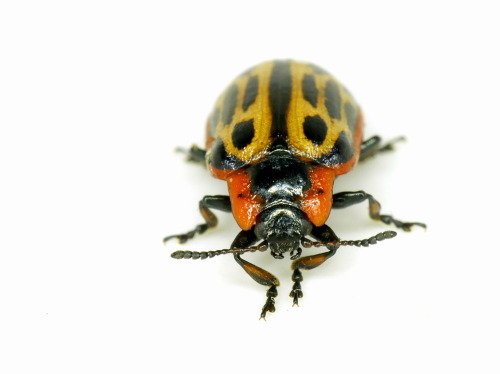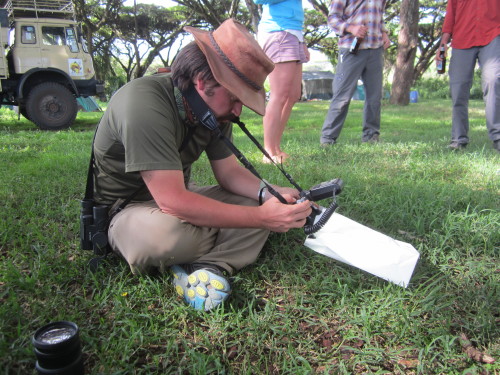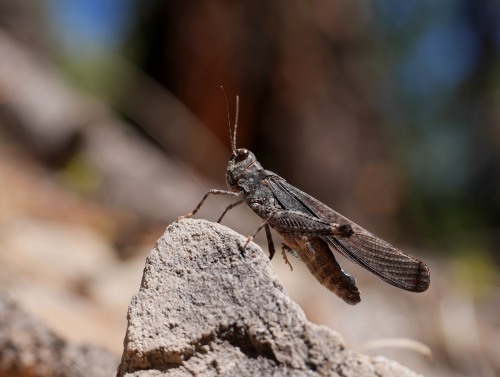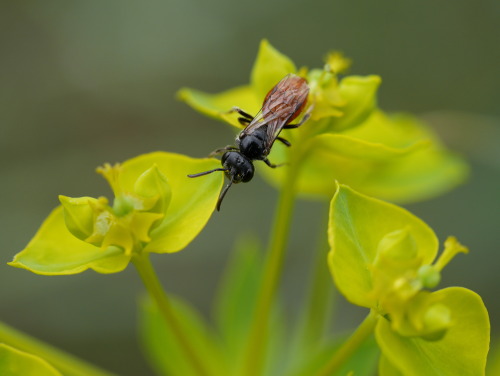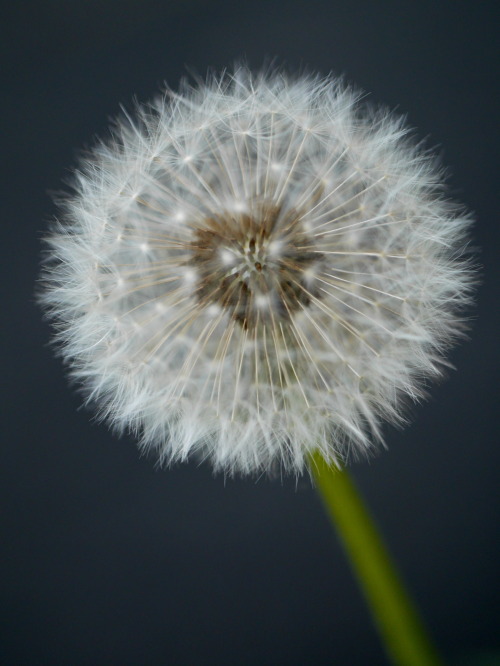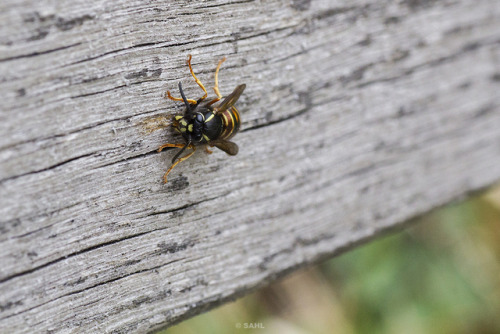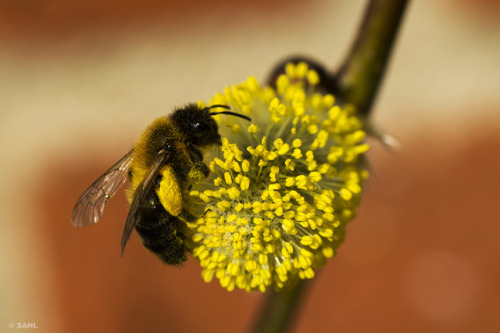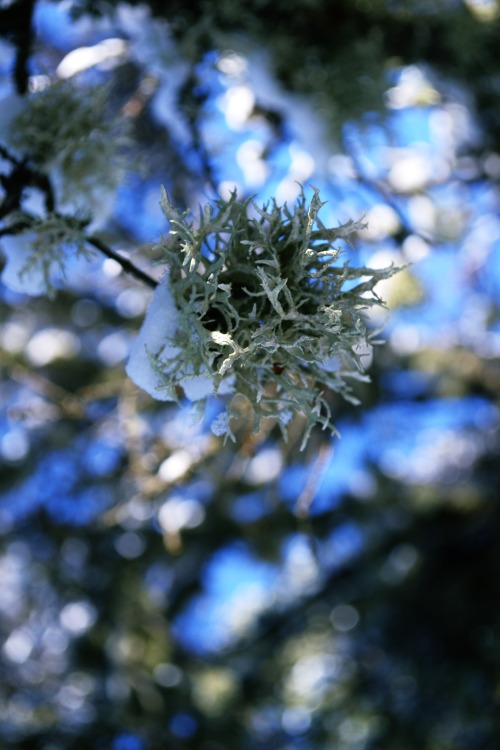#macro photography

This is Fennec. She’s new, she’s fast, and she’s SPICY!!!
Chrysis sp. “Cuckoo Wasp” Chrysididae
Missoula, MT
May 17, 2016
Robert Niese
Cuckoo Wasps are a massive, possibly polyphyletic group of parasitic wasps. More than half the members of this giant family are placed in the genus Chrysis(more than 1000 species!). Undoubtedly, in the coming years this genus will be stripped, split, and reorganized in favor of a more monophyletic and phylogenetically accurate set of genera. As their common name might suggest, cuckoo wasps lay their eggs in the nests of other wasps, and many specialize on a single host species. This lovely individual appeared to be waiting outside an old nail hole on the side of my house that was occupied by a cavity-nesting wasp of some sort.
Post link
Calligrapha verrucosa “Warty Willow Leaf Beetle” Chrysomelidae
Missoula, MT
May 26, 2016
Robert Niese
Caught, in flagrante delicto, mating right on the beach! Egads! These indiscreet little beetles are relatively closely related to those Cottonwood Beetles I posted yesterday. Their genus name “Calligrapha” is a reference to the beautiful calligraphic script on the backs of many species. This species’s coloration is not quite as script-like, but it definitely still appears painted. I’ll post some portraits later! These beetles are most common in the Northern Rockies of Montana, Alberta, and Saskatchewan, but, according to some older sources, their range is far broader, stretching from Nebraska to California to Alaska. If you have photographs of these beetles please submit them to me to supplement our scientific understanding of their distribution!
Post link
Chrysomela scripta “Cottonwood Leaf Beetle” Chrysomelidae
Missoula, MT
April 22, 2016
Robert Niese
These lovely beetles can spend their entire life cycles living off of a single poplar or cottonwood tree. Females lay their eggs in clusters on the undersides of leaves. Those eggs hatch and the larvae begin feeding on the leaf tissues until nothing but a skeleton of veins remains. Then, they pupate into adults which will continue the process of defoliating the tree by eating the thick veins and midribs left behind by the larvae. Some small saplings can be killed by a particularly hungry population of breeding Cottonwood Leaf Beetles. This species may not be present in the PNW west of the Cascades. If you discover them there, please let me know!
Post link
Robert, photographing beetles and exemplifying nerdity
Ngorongoro Crater Conservation Area, Tanzania
January 15, 2016
Juan Oteyza
I was recently asked how I go about creating bug portraits. Everyone has a different method to their madness, but mine tends to have a bit more madness in its method. First of all, I’m cheap. I use a $20 Polaroid macro ring light (that sucks batteries and refuses to communicate with my camera) and whatever white surfaces are available to me. In the field, I like using recycled white paper bags like the one here (it once held my malaria medication). And at home I use a white bowl (stolen from my university’s dining commons, shhhh, don’t tell).
Generally, I put the ring light on “light” mode (where it simply becomes an expensive flashlight) and adjust my settings to make the white look as naturally white as possible before introducing my subjects. Getting bugs to sit still is probably the most difficult part of this process. I don’t have any surefire ways to achieve this, but, because I tire of their shenanigans easily, I’ll often leave a bug in a vial overnight to let it calm the f*** down. Sometimes this works. Usually it doesn’t.
For some insects and arachnids, you just need to time your shots right. I find that most spiders tend to pause briefly while hopelessly traversing my endlessly white bowl (perhaps to contemplate their hopelessness, but more likely in an attempts to visually assess their world something something visual acuity). I’ve discovered that some beetles tire out quickly, so I harass them for a few minutes to prevent them from resting, before photographing them while they’re recuperating. Most beetles, however, seem to prefer to just curl up and hunker down, unfortunately. For these, I’ve found that gently (or ferociously, depending on my level of patience) blowing on them often gets them to emerge from their defensive state.
But that’s all just the set-up. The real star of the show is always the camera/lens (in my opinion). I use a compact mirrorless DSLR (a Panasonic GX7 and, in older photos, a DMC-GF3) which is relatively small and portable, so I can bring it everywhere I go. Literally everywhere. You never know when you’re going to find a really really cool bug (like this one which I discovered while pooping early one morning–or this one that crawled on me while I was nude sunbathing). Literally EVERYWHERE I GO. My lens for macro work is a Panasonic Leica DG Macro-Elmarit 45mm fixed lens for a micro 4/3 mount. He’s my pride and joy and the best purchase I have ever made.
As for editing software, I find that, if I’ve done the set-up and shooting correctly, not much gets done on the back-end, so I use Google’s old Picasa software (free!) for basic fine-tuning. They recently discontinued service for this product and are pushing their mobile app “Snapseed” instead. I recently tried out Snapseed and am amazed at its capabilities. I just refuse to do all my photo editing on a phone. I’ll figure it out eventually.
Feel free to ask any other questions you might have! Cheers!
Post link
Oxyopes scalaris “Western Lynx Spider” Oxyopidae
Missoula, MT
May 6, 2016
Robert Niese
Lynx spiders are some of my favorite arachnids! They’re stealthy, fast, agile and ferocious predators, some of which specialize on other spiders! Oxyopes scalaris is virtually the only species of lynx found in the PNW, however. It can be found in just about any habitat from the coast to the Rockies and as far north as BC. One additional species, the Striped Lynx (O. salticus) can be found along the coast from California through Oregon and, rarely, in southern Washington.
Post link
Oemleria cerasiformis “Indian Plum” Rosaceae
Washington Park Arboretum, Seattle, WA
May 9, 2016
Robert Niese
Oemleriais a PNW endemic and is one of the first plants to leaf-out and bloom in spring. Later in the summer Oemleria will begin to bear ripe fruits which are purple with a large pit, giving them the name Indian Plums. Opinions vary on the palatability of these fruits. Some find them to be among the best in the PNW, while others find them too bitter. Generally, their astringency can be reduced through cooking and, as such, Oemleria fruits tend to be most commonly prepared in jams and pie fillings. Also, their bark is thought to be a mild aphrodisiac. Someone should try chewing on a few twigs and report back to us all.
Post link
Campanula rotundifolia “Mountain Harebell” Campanulaceae
Two Medicine, Glacier National Park, MT
October 8, 2015
Robert Niese
The Mountain Harebell has a circumpolar distribution where it tends to be a late-blooming perennial. As a native of the British Isles, the harebell has attracted the attention of many a great English poet, including William Shakespeare, John Clare, and Christina Rossetti. Here in the PNW, the Haida people called them “blue rain flowers” and believed that picking them would cause it to rain.
Post link
Trimerotropis verruculata suffusa “Crackling Forest Grasshopper” Acrididae
Mt. Sentinel, Lolo National Forest, MT
September 12, 2015
Robert Niese
BugGuide has become an indispensable resource for all my insect identification needs, but rarely do I come across pages so eloquently and comprehensively written as those by David Ferguson. His passion for band-winged grasshoppers makes these entries a joy to read:
“T. verruculata suffusa is one of the most common and conspicuous Band-wing Grasshoppers in open pine forests of the Rockies and Sierras, where it can be seen (and heard) on most any warm summer or autumn day. The “crepitation” produced in flight is a relatively loud crackling sound, and sometimes males will hover and crackle for several seconds at a time. Never is it so loud and conspicuous as Circotettixspecies (to which it is related and similar), but nearly so.”
Post link
Sphecodes(arvensiformis) “Cuckoo Sweat Bee” Halictidae
onEuphorbia esula “Leafy Spurge” Euphorbiaceae
Blue Mountain National Recreation Area, MT
May 16, 2016
Robert Niese
Sphecodesbees are cleptoparasitic, cuckoo-like bees that lay their eggs in the nests of other sweat bees. Despite their outward appearance, these insects are not wasps, but they have converged on a very cuckoo-wasp-like life-history strategy. A female enters the nests of another Halictid, consumes a developing egg and replaces it with her own. Unfortunately, these bees, like the vast majority of Halictids, are very poorly studied and there are few entomologists capable of accurately identifying them beyond the genus level. Oh, and by the way, Leafy Spurge, while it is one of Missoula’s most widespread invasives, is also one of my favorite spring plants. They’re just such odd organisms! More photos and natural history info to come, I’m sure.
Looking back at my other photos of these bees from years ago makes me realize how far my skills as a photographer and natural historian have progressed.
Post link
Hygrophorus speciosus “Brilliant Wax-cap” Basidiomycota
Blue Mountain National Recreation Area, MT
May 16, 2016
Robert Niese
The wax-caps were once considered to all be members of the genus Hygrophorus, but have recently been divided into several new genera, all of which are still taxonomically debated. This particular species remains in the genus Hygrophorus due to its ectomicorrhizal growth habit. You can find it in drier, east-side forests where larch is abundant.
Post link
Taraxacum officinale “Common Dandelion” Asteraceae (Compositae)
Missoula, MT
May 2, 2016
Robert Niese
Generic, but beautiful nonetheless. Each of those tiny wind dancers is actually a fruit called an achene. Each achene arose from an individual flower of which there are hundreds in a single dandelion head (actually there are only 50-200 flowers per head, but “hundreds” sounds better) . This is where the family got its old name, “Compositae.” Each of their composite “flowers” are made up of loads of tiny individual flowers. So next time your lover asks for flowers, pick them a couple dandelions and astound them with an offering of many hundreds of flowers instead of a measly dozen roses.
Post link
Lasioglossum(Hemihalictus) sp. “Weak-veined Sweat Bee” Halictidae
onSolidago missouriensis. “Prairie Goldenrod” Asteraceae
Apgar Lookout Trail, Glacier National Park, MT
October 9, 2015
Robert Niese
Lasioglossum is the world’s largest genus of bees and contains more than 1700 species worldwide. Like many other speciose invertebrate genera, we know relatively little about these organisms and only a handful of entomologists worldwide are capable of identifying them to species. In the last five years, researchers throughout North America have revised the taxonomy of this group using phylogenetic data, new morphological characters, and over 10,000 museum specimens. According to their keys, this particular individual is possibly a male L. (Hemihalictus)inconditum.
Post link




